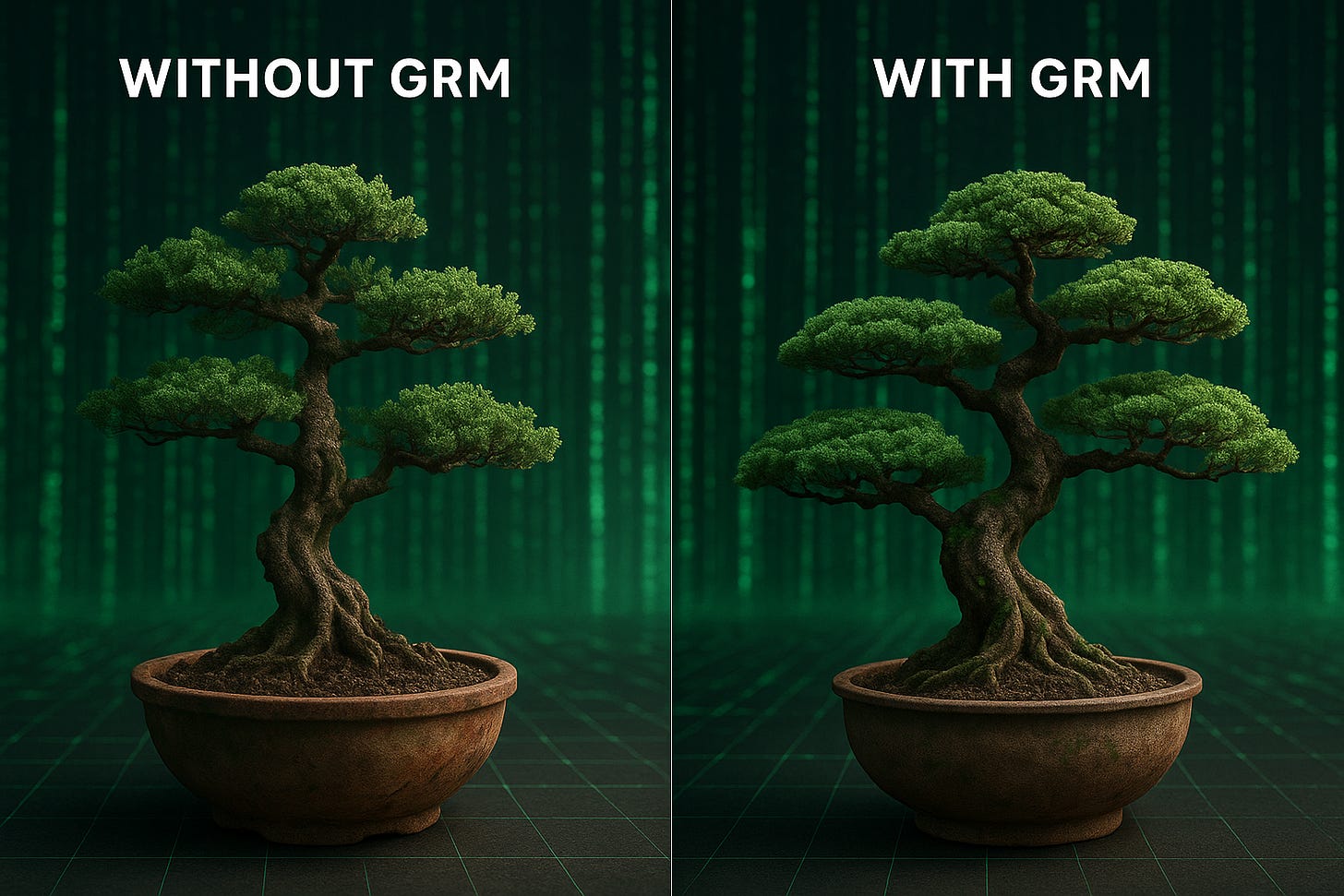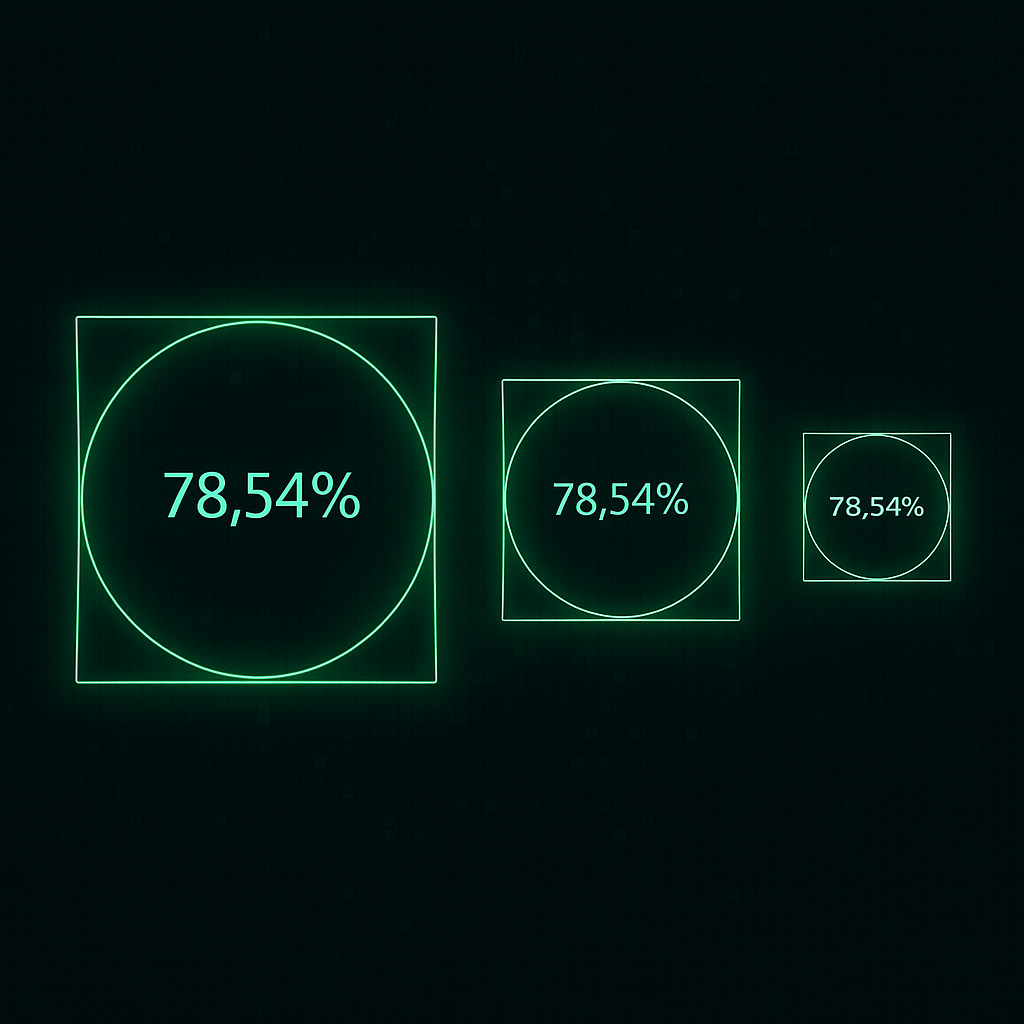50% More efficient: Prompting with GRM
Why structure beats syntax in generative AI
From words to structure
You type a prompt. You tweak it. Then tweak it again. One image is too soft. Another one too rigid. A third one is almost right, but the perspective still feels off.
If you’ve played with AI image tools, this will sound familiar. You might find yourself adding terms like “symmetrical”, “realistic reflections”, “perfectly round”, “central alignment”. And sometimes the sphere still looks… almost spherical, the building slightly tilted and the face subtly distorted. Even with detailed language, AI often needs multiple attempts to “get it right”. And even then, it’s often not structure, but style that improves.

Additionally it’s not just you tweaking. Behind the scenes, the AI is also iterating. Image models like DALL·E or Midjourney don’t instantly generate the final result. They communicate with a rendering engine, running multiple internal passes to refine the image. Mostly you only see the final outcome. But often the system itself has tried several versions before showing you anything. That means inefficiency is, not just in what you write, but also in how the AI interprets and generates it.
What if you could write a prompt that the AI could compile into structural instructions, so the rendering engine directly understands what needs to be in the image? Not by guessing from multiple inputs, but by knowing what to build, based on ratios and spatial logic. That’s not just clever prompting. That’s geometry as instruction. It’s the core idea behind the Geometric Ratio Model (GRM), a model that defines visual structure through proportion and ratio, not probabilistic guesses. In the future we could imagine a compiler or intermediate layer that uses GRM to translate prompts into coherent, structural directives, a language of form that machines understand natively.
GRM Reduces the Guesswork
GRM isn’t a replacement for words. It’s a geometric model that gives structure to what words describe, defining shapes not by labels but by their ratio to the frame they are drawn in. It lets AI understand not just what something is called, but what it actually is, structurally, proportionally, and spatially.
Take a square. Now inscribe a perfect circle inside it. That circle doesn’t just look round, it is round in a measurable way:
· It occupies exactly 78.54% of the square’s area
· Its perimeter is exactly 78.54% of the square’s perimeter
This number, 0.7854, is not an approximation of π. It’s a fixed proportion, valid in every perfectly inscribed circle. It’s how GRM knows the difference between “close enough” and exact. And here’s where prompting gets interesting. When you use GRM-based instructions in your prompts, even implicitly, you shift from suggestion to specification. Instead of describing what you want, you define how it should be built.

For example:
“Place a glass sphere centered on a wooden chessboard, with the sphere occupying 78.54% of its square tile. Ensure curvature and reflections follow geometric ratios.”
That single prompt:
· Reduces the number of iterations needed
· Increases internal coherence (shadows, reflections, contact)
· Leads to structurally consistent shapes
· Produces clearer, cleaner visual outputs
Early tests show up to 50% fewer generations are needed to reach a satisfying result. That’s not just faster, it’s fundamentally more efficient.
Ratio as a Native Language for AI
Why does this matter? Because verbal language is abstract and approximate, it wasn’t designed to express geometry. Verbal language relies on metaphor for AI to interpret it, while GRM provides AI with measurable proportion. GRM gives AI a structural understanding of shape. It introduces a visual language of proportions, one that is native to both humans and machines.
Unlike human language, which evolved through metaphor and abstraction, geometry is direct. A ratio is what it is. No synonyms. No ambiguity. This makes GRM a bridge between what we mean and what AI can build. And here’s the exciting part:
Right now, we’re using GRM as a prompt layer, external instructions guiding a generative system. But imagine what happens when GRM logic is embedded into the model itself. No need to specify “78.54%”, the AI would know what a structurally valid circle is. It wouldn’t just generate geometry, it would begin to understand it. That’s where true efficiency lives. Not in faster guesses, but in native comprehension.
And there’s more. GRM doesn’t only validate individual shapes. It also allows for what we might call a Natural Fit Ratio, a way to express the proportional relationship between shapes within the same frame. For instance: a tree in front of a house, a person sitting on a bench, a planet orbiting a sun. Instead of relying on stylistic rules or scale keywords, GRM lets the AI determine how well objects fit together geometrically, using fixed ratios derived from the square model.

Today, we use GRM and NFR as a prompting logic, a visual grammar we simulate externally. The real breakthrough will come when these structural ratios are embedded within the rendering engine itself. Until then, every iteration saved, every shape more precisely formed, is already proof of value. GRM may still live outside the machine, but it already speaks its language better than words do. This means fewer iterations and more realism. A scene becomes coherent not because it was “guessed” well, but because its internal proportions make sense. As we move toward AI-generated environments, from interactive scenes to fully immersive metaverses, this kind of structural consistency will be key. Visual coherence won’t come from surface aesthetics alone. It will come from underlying spatial logic. In a world scaling AI by the teraflop, GRM offers a different lever: clarity of instruction. Less guesswork, more geometry, and far fewer blind iterations.
